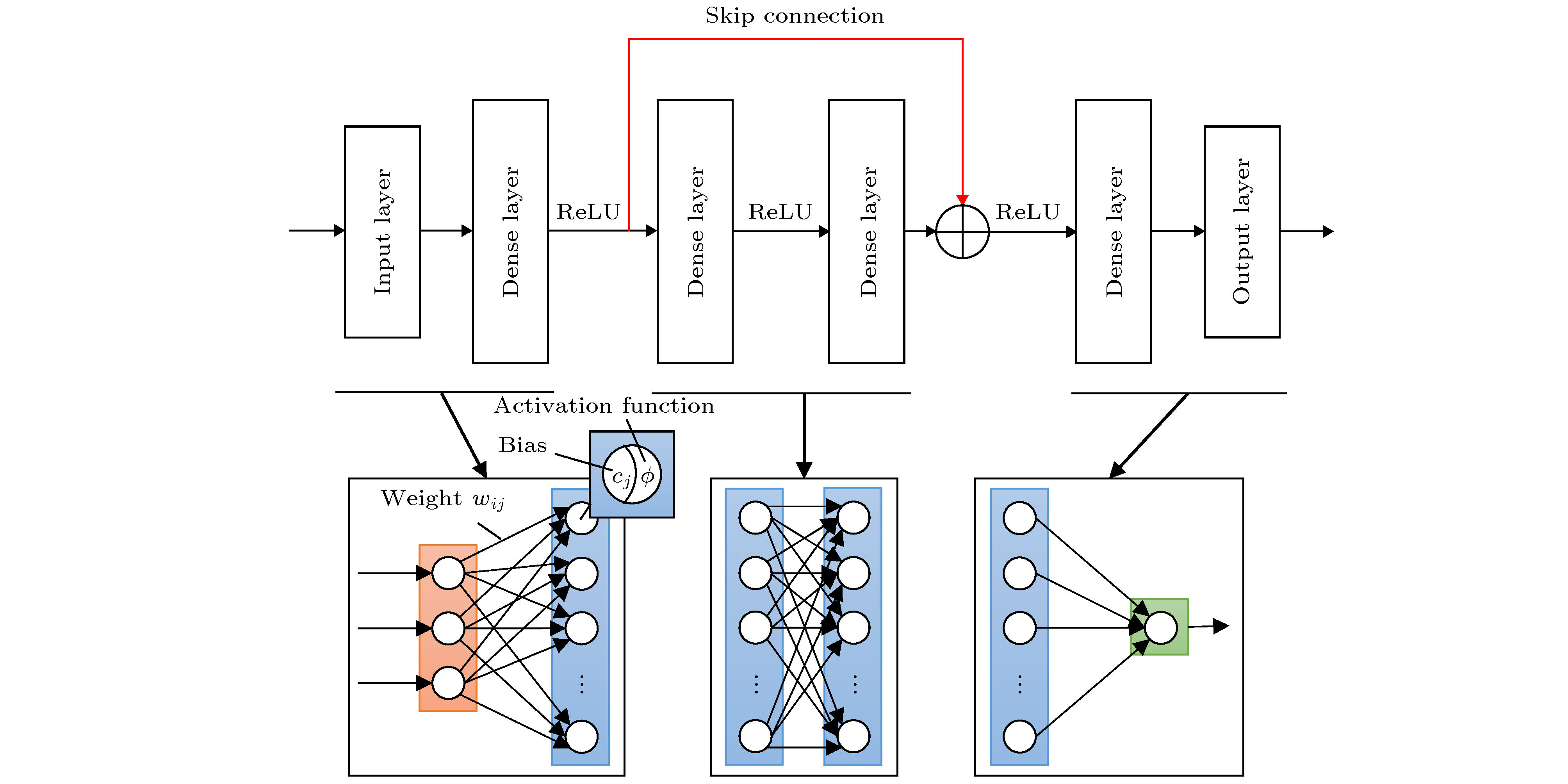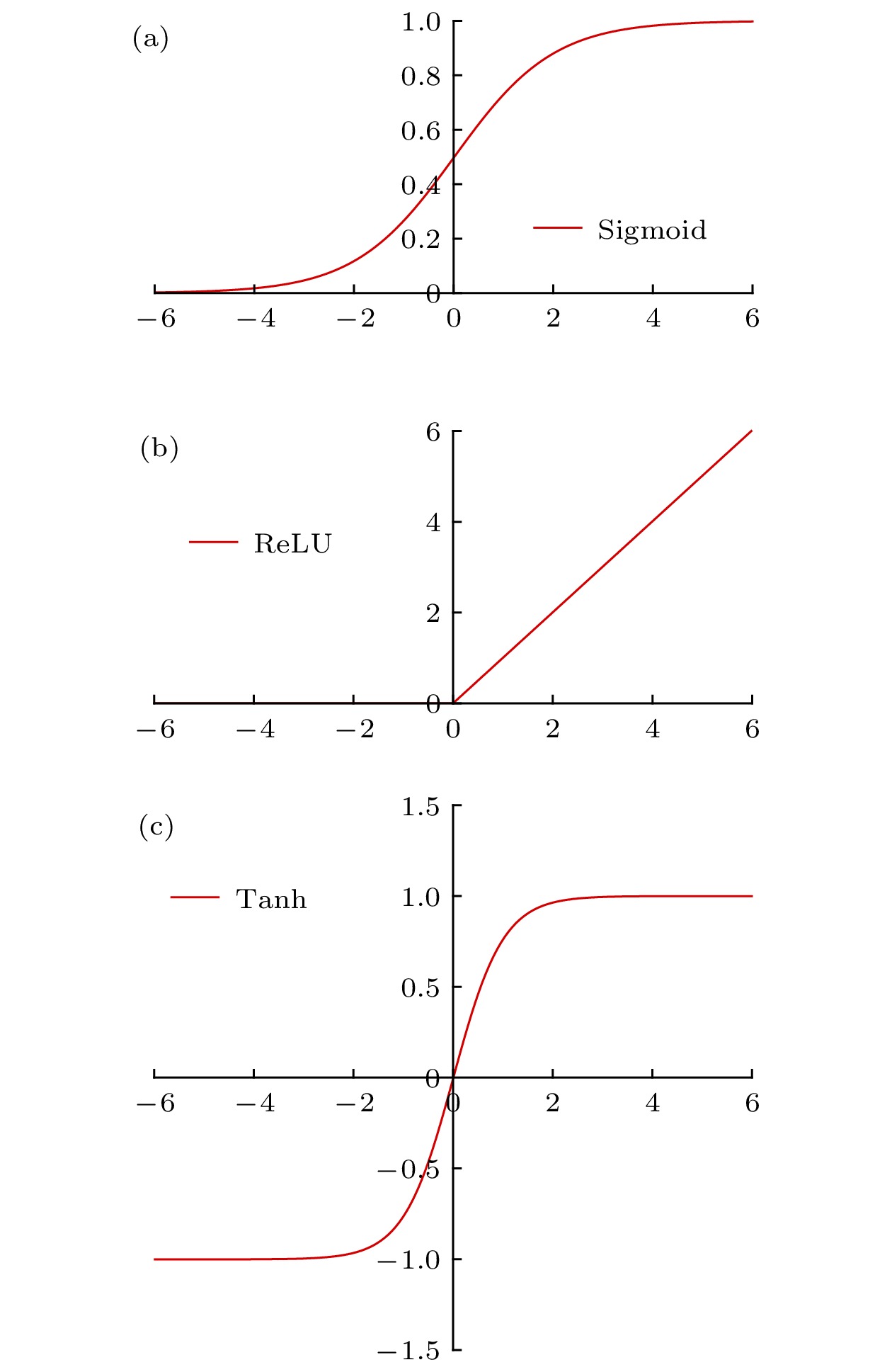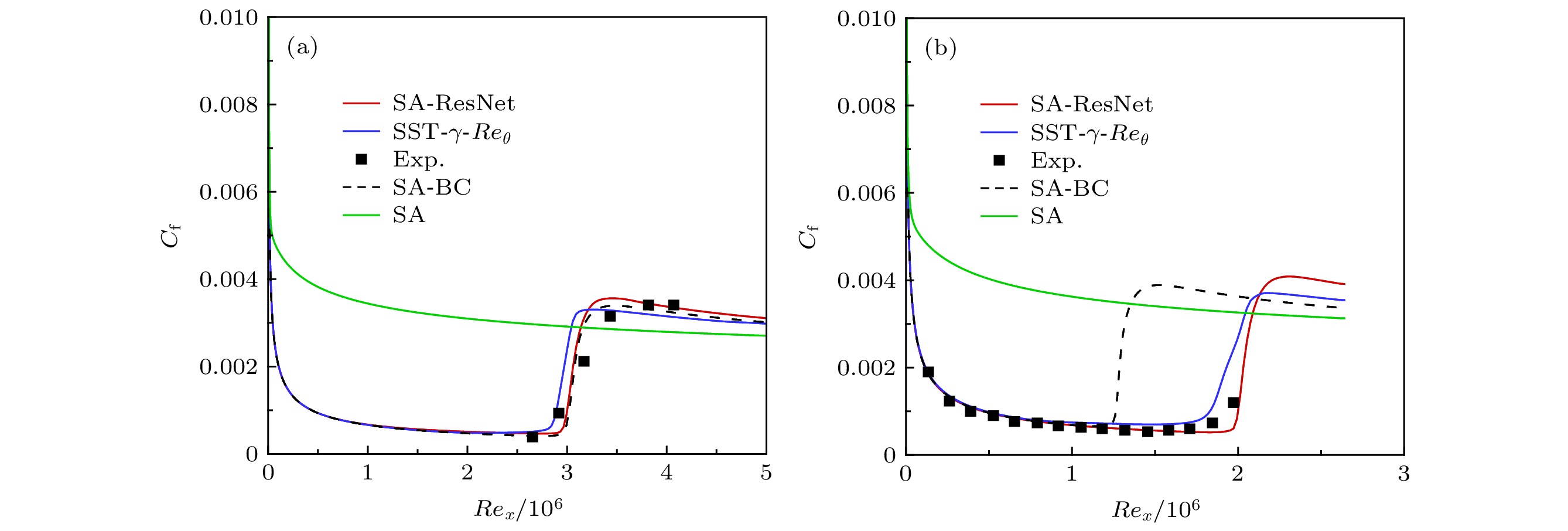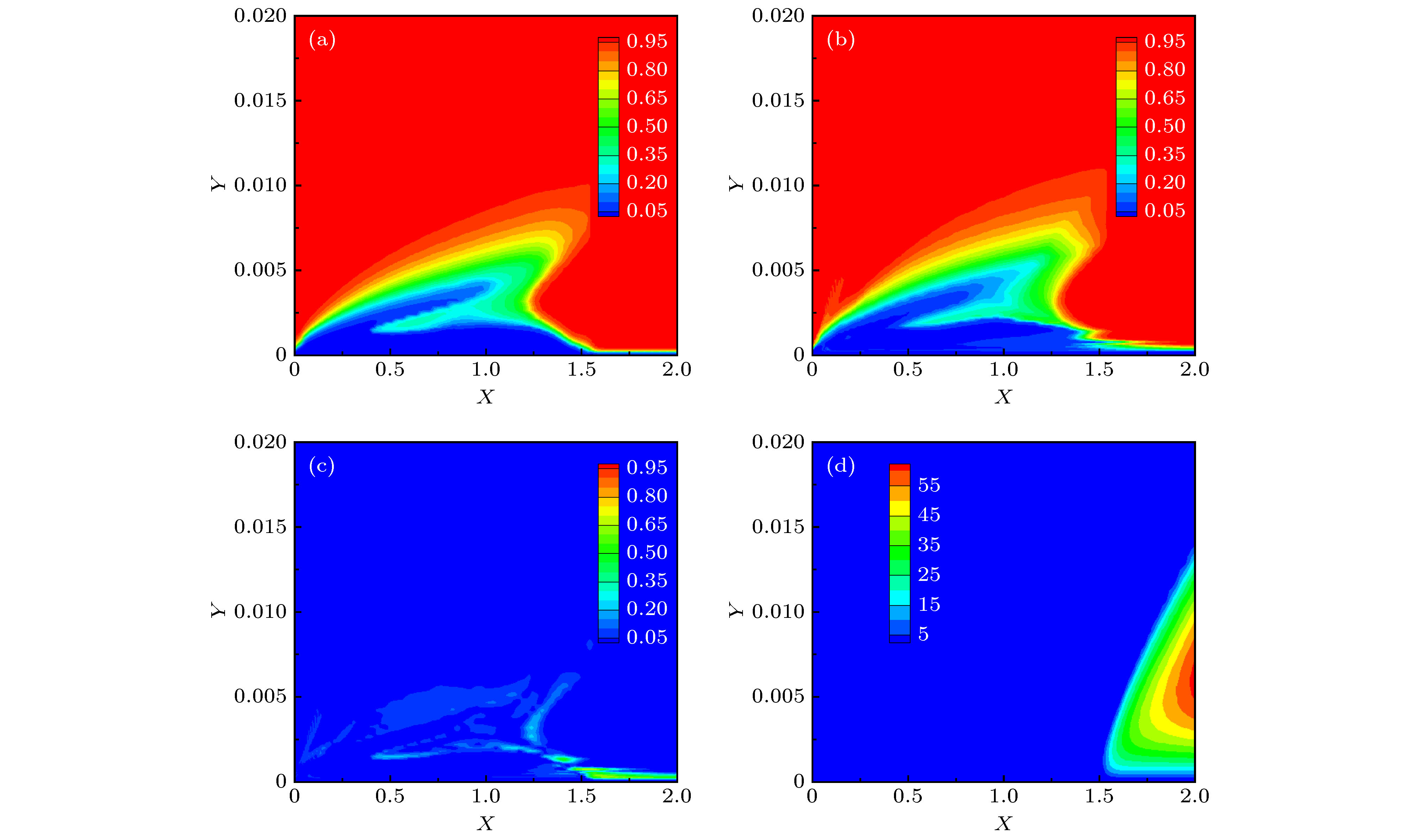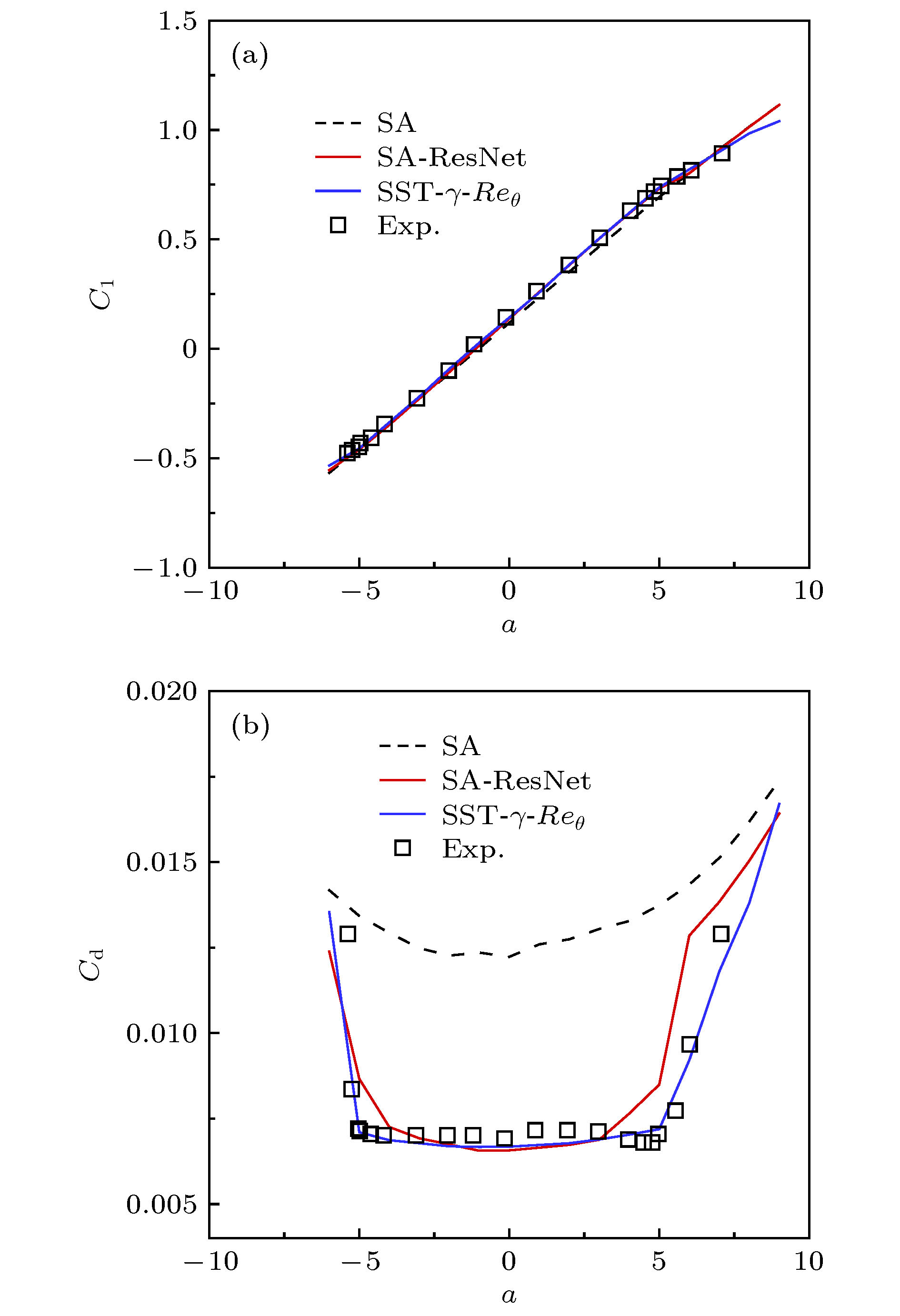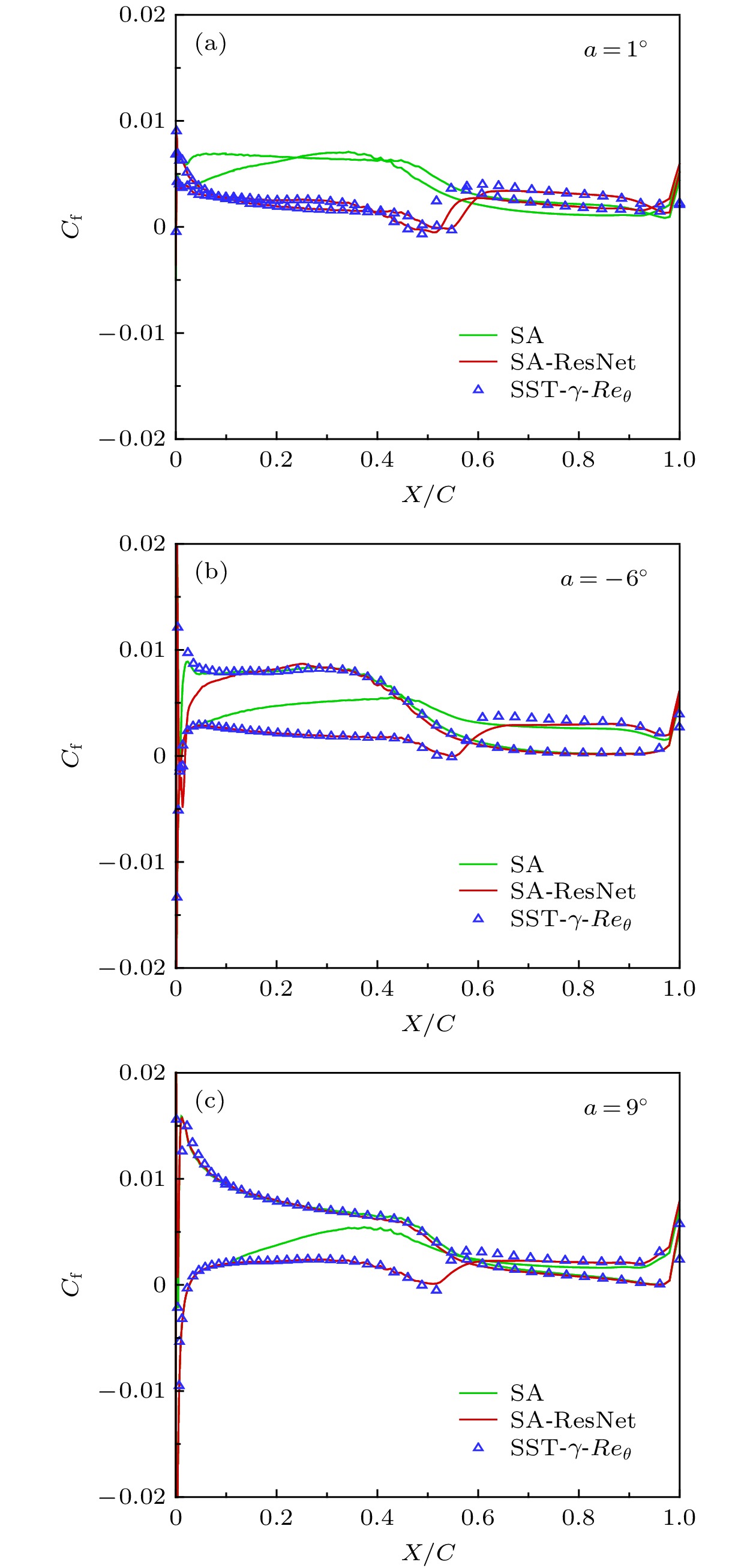-
结合机器学习的湍流模型是流体力学领域的研究热点之一. 现有方法主要将实验/数值的数据用于重构或修正湍流涡黏性和雷诺应力, 鲜有针对转捩问题的研究. 本文利用深度残差网络(ResNet)重构了间歇因子与流场平均量间的映射函数, 并与Spallart-Allmaras (SA)模型耦合, 发展了一种类代数转捩模型. 结合高精度加权紧致非线性格式(WCNS-E6E5)在转捩平板和S809翼型算例中进行了验证, 并与四方程的SST-γ-Reθ转捩模型进行了对比, 结果表明: 纯数据驱动的ResNet模型能够准确预测间歇场, 很大程度上改善了SA模型对自然转捩流动的模拟能力; 训练数据仅基于两个零压力梯度转捩平板, 模型能够应用于S809翼型不同迎角的情况, 预测的升阻力特性和摩擦系数分布接近SST-γ-Reθ转捩模型的结果; 在此基础上, 相较SST-γ-Reθ模型节省了超过30%的计算成本. 本研究显示了机器学习方法在转捩模型构建中的强大潜力.Turbulence model combined with machine learning is one of the research hotspots in fluid mechanics. The existing approaches reconstruct or modify the turbulence eddy viscosity or Reynolds stress based on the experimental/numerical data. In this paper, we reconstruct the mapping function between intermittency and the mean flow variables by deep neural network (ResNet), developing an quasi-algebraic transition model coupled with the Spallart-Allmaras (SA) model. We mainly concentrate on the natural transition flows and take the results calculated by the computational fluid dynamics solver with the SST-γ-Reθ model as the training data. Seventeen local mean flow quantities satisfying the Galilean invariants are selected as the input features. Five-time cross validation is performed to avoid overfitting. Combining with the high-precision weighted compact nonlinear format, S&K, T3a- transition plate and S809 airfoil are used to test the performance of the model. The results are compared with those from the SST-γ-Reθ transition model, showing that the pure data-driven ResNet model can predict the intermittent field accurately, which greatly improves the ability of SA model to simulate the natural transition flow. For the example of S&K and T3a- transition plate, the comparison of wall friction shows that the SA-ResNet model is in good agreement with the experimental result, but the BC model, which is also an algebraic model, predicts the transition position of the T3a- transition plate model prematurely. The training data do not contain any numerical solution about airfoil, but the model can still be applied to the case of S809 airfoil with different attack angles. The predicted results of lift resistance characteristics, frictional coefficient distribution and transition position are close to the results from the SST-γ-Reθ transition model. On this basis, another advantage of the model is the solution efficiency. The efficiency is improved more significantly in the case with larger mesh quantity. With the same convergence accuracy, the CPU time required by the SA-ResNet model for the S&K plate case is 85.6% that of the SST-γ-Reθ transition model, while the CPU time required by the S809 airfoil with a larger mesh volume is only 67.2% that of the later model. This study demonstrates the great potential of machine learning in the construction of transition models.
-
Keywords:
- transition flow /
- neural network /
- intermittency /
- weighted compact nonlinear scheme
[1] Crouch J 2008 38th Fluid Dynamics Conference and Exhibit Seattle, Washington, June 23–26, 2008 p3832
[2] Lardeau S, Li N, Leschziner M A 2006 J. Turbomach. 129 311
 Google Scholar
Google Scholar
[3] Gropp W, Khodadoust A, Slotnick J, Mavriplis D, Darmofal D, Alonso J, Lurie E http://ntrs.nasa.gov/search.jsp?R= 20140003093
[4] Rumsey C L 2016 52nd Aerospace Sciences Meeting National Harbor, Maryland, January 13–17, 2014 p201
[5] 符松, 王亮 2007 力学进展 37 409
 Google Scholar
Google Scholar
Fu S, Wang L 2007 Adv. Mech. 37 409
 Google Scholar
Google Scholar
[6] Dhawan S, Narasimha R 1958 J. Fluid Mech. 3 418
 Google Scholar
Google Scholar
[7] Libby P A 1975 J. Fluid Mech. 68 273
 Google Scholar
Google Scholar
[8] Cho J R 1982 J. Fluid Mech. 237 301
 Google Scholar
Google Scholar
[9] Steelant J, Dick E 2001 J. Fluids Eng. 123 22
 Google Scholar
Google Scholar
[10] Menter F R, Langtry R B, Likki S R, Suzen Y B, Huang P G, Voölker S 2006 J. Turbomach. 128 413
 Google Scholar
Google Scholar
[11] Langtry R B, Menter F R, Likki S R, Suzen Y B, Huang P G, Voölker S 2006 J. Turbomach. 128 423
 Google Scholar
Google Scholar
[12] Langtry R B, Menter F R 2009 AIAA J. 47 2894
 Google Scholar
Google Scholar
[13] Howison J, Ekici K 2015 Wind Energy 18 2047
 Google Scholar
Google Scholar
[14] Nandi T N, Brasseur J, Vijayakumar G 2016 34th Wind Energy Symposium San Diego, California, USA, January 4–8, 2016 p520
[15] 王光学, 王圣业, 葛明明, 邓小刚 2018 物理学报 67 175
 Google Scholar
Google Scholar
Wang G X, Wang S Y, Ge M M, Deng X G 2018 Acta Phys. Sin. 67 175
 Google Scholar
Google Scholar
[16] Bas O, Cakmakcioglu S C, Kaynak U 2013 31st AIAA Applied Aerodynamics Conference San Diego, CA, June 24–27, 2013 p2531
[17] Cakmakcioglu S C, Bas O, Kaynak U 2017 Proc. Inst. Mech. Eng., Part C 232 3915
 Google Scholar
Google Scholar
[18] He K, Zhang X, Ren S, Sun J 2015 arXiv e-prints arXiv: 1512.03385
[19] Ling J, Kurzawski A, Templeton J 2016 J. Fluid Mech. 807 155
 Google Scholar
Google Scholar
[20] Ling J, Ruiz A, Lacaze G, Oefelein J 2016 J. Turbomach. 139
 Google Scholar
Google Scholar
[21] Zhang W, Zhu L, Liu Y, Kou J 2018 arXiv e-prints arXiv: 1806.05904
[22] Zhang Z J, Duraisamy K 2015 22 nd AIAA Computational Fluid Dynamics Conference Dallas, TX, USA, June 22–26, 2015 p2460
[23] Duraisamy K, Zhang Z J, Singh A P 2015 53 rd AIAA Aerospace Sciences Meeting Kissimmee, Florida, January 5–9, 2015 p1284
[24] Ge X, Arolla S, Durbin P 2014 Flow, Turbul. Combust. 93 37
 Google Scholar
Google Scholar
[25] Wang Y, Zhang Y, Li S, Meng D 2015 Chin. J. Aeronaut. 28 704
 Google Scholar
Google Scholar
[26] 李松 2015 博士学位论文 (绵阳: 中国空气动力研究与发展中心)
Li S 2015 Ph. D. Dissertation (Mianyang: China Aerodynamics Research and Development Center) (in Chinese)
[27] Deng X, Liu X, Mao M, Zhang H 2012 17th AIAA Computational Fluid Dynamics Conference Toronto, Ontario, Canada, June 6–9, 2005 p5246
[28] Deng X, Zhang H 2000 J. Comput. Phys. 165 22
 Google Scholar
Google Scholar
[29] Spalart P, Allmaras S 30th Aerospace Sciences Meeting and Exhibit Reno, NV, U.S.A. January 6–9, 1992 p439
[30] Singh A P, Medida S, Duraisamy K 2017 AIAA J. 55 2215
 Google Scholar
Google Scholar
[31] Medida S, Baeder J 2012 20th AIAA Computational Fluid Dynamics Conference Honolulu, Hawaii, June 27–30, 2011 p3979
[32] 周志华 2016 机器学习(北京: 清华大学出版社) 第113—114页
Zhou Z H 2016 Machine learning (Beijing: Tsinghua University Press) pp113–114 (in Chinese)
[33] Kingma D P, Ba J 2014 arXiv e-prints arXiv: 1412.6980
[34] Wang J X, Wu J L, Xiao H 2017 Phys. Rev. Fluids 2 034603
 Google Scholar
Google Scholar
[35] 王圣业, 王光学, 董义道, 邓小刚 2017 物理学报 66 184701
 Google Scholar
Google Scholar
Wang S Y, Wang G X, Dong Y D, Deng X G 2017 Acta Phys. Sin. 66 184701
 Google Scholar
Google Scholar
[36] 陈勇, 郭隆德, 彭强, 陈志强, 刘卫红 2015 物理学报 64 134701
 Google Scholar
Google Scholar
Chen Y, Guo L D, Peng Q, Chen Z Q, Liu W H 2015 Acta Phys. Sin. 64 134701
 Google Scholar
Google Scholar
[37] Somers D M 1997 Design and Experimental Results for the S809 Airfoil Report
[38] Wang S, Ge M, Deng X, Yu Q, Wang G 2019 AIAA J. 57 4684
 Google Scholar
Google Scholar
[39] Bengio Y 1994 IEEE Trans. Neural Networks 2 157
 Google Scholar
Google Scholar
[40] Glorot X, Bengio Y 2010 J. Mach. Learn. Res. Proc. Track 9 249
-
图 7 T3A-平板间歇因子和湍流黏性分布 (a) SST-γ-Reθ预测γ场; (b) SA-ResNet预测γ场; (c) SST-γ-Reθ和SA-ResNet预测γ的差异; (d) SA-ResNet预测的湍流黏性
Fig. 7. Intermittency and turbulent viscosity distribution of T3A- case: (a) γ from SST-γ-Reθ; (b) γ from SA-ResNet; (c) discrepancy of γ between SST-γ-Reθ and SA-ResNet; (d) turbulent viscosity from SA-ResNet.
表 1 作为神经网络输入的流场局部平均特征量
Table 1. The local average flow features used as the inputs of neural network.
Feature Sign Feature Sign Density $\rho $ Scalar function 3[19] ${\rm Tr}({ {{S} }^3})$ Nearest wall distance ${d_w}$ Scalar function 4[19] ${\rm Tr}({ {{\varOmega } }^2}{{S} })$ Turbulence intensity Tu Scalar function 5[19] ${\rm Tr}({ {{\varOmega } }^2}{ {{S} }^2})$ Kinematic viscosity $\nu $ Normalized strain rate ${{\left\| {{S}} \right\|} / {\left( {\left\| {{S}} \right\|{\rm{ + }}\left\| {{\varOmega }} \right\|} \right)}}$ Eddy viscosity ${\nu _t}$ Vortex Reynolds number (strain rate) ${{\rho d_w^2 S} / \mu }$ Reciprocal of local velocity $1/U$ Vortex Reynolds number (vorticity) ${{\rho d_w^2\Omega } / \mu }$ Scalar function 1[19] ${\rm Tr}({ {{S} }^2})$ Q criterion[34] $\dfrac{ {\dfrac{1}{2}\left( { { {\left\| {{\varOmega } } \right\|}^2} - { {\left\| {{S} } \right\|}^2} } \right)} }{ {\dfrac{1}{2}\left( { { {\left\| {{\varOmega } } \right\|}^2} - { {\left\| {{S} } \right\|}^2} } \right) + { {\left\| {{S} } \right\|}^2} } }$ Scalar function 2[19] ${\rm Tr}({ {{\varOmega } }^2})$ Ratio of modified viscosity to
kinematic viscosity (χ)${{\widetilde \nu } / \nu }$ Dimensionless quantity similar to
turbulent viscosity${{{\nu _t}} / {\left( {U{d_w}} \right)}}$ 表 2 5次交叉验证结果
Table 2. Results of fivefold cross validation.
Fold Training error Validation error 1 0.011719 0.013654 2 0.012549 0.010681 3 0.015313 0.018738 4 0.012985 0.015888 5 0.015822 0.014451 表 3 平板算例入口条件
Table 3. The entry condition of plate cases.
Case U/m·s–1 Re∞ Tu∞/% S&K 50.1 3.4 × 106 0.179 T3A- 19.8 1.4 × 106 0.843 表 4 模型计算时间对比(残差收敛至O(10–4))
Table 4. Comparison of transition model’s compu-ting time.
ComputingTime SA SA-ResNet SST-γ-Reθ S&K 1.0 1.11 1.30 T3A- 1.0 1.33 1.49 S809 (α = 3°) 1.0 1.20 1.78 -
[1] Crouch J 2008 38th Fluid Dynamics Conference and Exhibit Seattle, Washington, June 23–26, 2008 p3832
[2] Lardeau S, Li N, Leschziner M A 2006 J. Turbomach. 129 311
 Google Scholar
Google Scholar
[3] Gropp W, Khodadoust A, Slotnick J, Mavriplis D, Darmofal D, Alonso J, Lurie E http://ntrs.nasa.gov/search.jsp?R= 20140003093
[4] Rumsey C L 2016 52nd Aerospace Sciences Meeting National Harbor, Maryland, January 13–17, 2014 p201
[5] 符松, 王亮 2007 力学进展 37 409
 Google Scholar
Google Scholar
Fu S, Wang L 2007 Adv. Mech. 37 409
 Google Scholar
Google Scholar
[6] Dhawan S, Narasimha R 1958 J. Fluid Mech. 3 418
 Google Scholar
Google Scholar
[7] Libby P A 1975 J. Fluid Mech. 68 273
 Google Scholar
Google Scholar
[8] Cho J R 1982 J. Fluid Mech. 237 301
 Google Scholar
Google Scholar
[9] Steelant J, Dick E 2001 J. Fluids Eng. 123 22
 Google Scholar
Google Scholar
[10] Menter F R, Langtry R B, Likki S R, Suzen Y B, Huang P G, Voölker S 2006 J. Turbomach. 128 413
 Google Scholar
Google Scholar
[11] Langtry R B, Menter F R, Likki S R, Suzen Y B, Huang P G, Voölker S 2006 J. Turbomach. 128 423
 Google Scholar
Google Scholar
[12] Langtry R B, Menter F R 2009 AIAA J. 47 2894
 Google Scholar
Google Scholar
[13] Howison J, Ekici K 2015 Wind Energy 18 2047
 Google Scholar
Google Scholar
[14] Nandi T N, Brasseur J, Vijayakumar G 2016 34th Wind Energy Symposium San Diego, California, USA, January 4–8, 2016 p520
[15] 王光学, 王圣业, 葛明明, 邓小刚 2018 物理学报 67 175
 Google Scholar
Google Scholar
Wang G X, Wang S Y, Ge M M, Deng X G 2018 Acta Phys. Sin. 67 175
 Google Scholar
Google Scholar
[16] Bas O, Cakmakcioglu S C, Kaynak U 2013 31st AIAA Applied Aerodynamics Conference San Diego, CA, June 24–27, 2013 p2531
[17] Cakmakcioglu S C, Bas O, Kaynak U 2017 Proc. Inst. Mech. Eng., Part C 232 3915
 Google Scholar
Google Scholar
[18] He K, Zhang X, Ren S, Sun J 2015 arXiv e-prints arXiv: 1512.03385
[19] Ling J, Kurzawski A, Templeton J 2016 J. Fluid Mech. 807 155
 Google Scholar
Google Scholar
[20] Ling J, Ruiz A, Lacaze G, Oefelein J 2016 J. Turbomach. 139
 Google Scholar
Google Scholar
[21] Zhang W, Zhu L, Liu Y, Kou J 2018 arXiv e-prints arXiv: 1806.05904
[22] Zhang Z J, Duraisamy K 2015 22 nd AIAA Computational Fluid Dynamics Conference Dallas, TX, USA, June 22–26, 2015 p2460
[23] Duraisamy K, Zhang Z J, Singh A P 2015 53 rd AIAA Aerospace Sciences Meeting Kissimmee, Florida, January 5–9, 2015 p1284
[24] Ge X, Arolla S, Durbin P 2014 Flow, Turbul. Combust. 93 37
 Google Scholar
Google Scholar
[25] Wang Y, Zhang Y, Li S, Meng D 2015 Chin. J. Aeronaut. 28 704
 Google Scholar
Google Scholar
[26] 李松 2015 博士学位论文 (绵阳: 中国空气动力研究与发展中心)
Li S 2015 Ph. D. Dissertation (Mianyang: China Aerodynamics Research and Development Center) (in Chinese)
[27] Deng X, Liu X, Mao M, Zhang H 2012 17th AIAA Computational Fluid Dynamics Conference Toronto, Ontario, Canada, June 6–9, 2005 p5246
[28] Deng X, Zhang H 2000 J. Comput. Phys. 165 22
 Google Scholar
Google Scholar
[29] Spalart P, Allmaras S 30th Aerospace Sciences Meeting and Exhibit Reno, NV, U.S.A. January 6–9, 1992 p439
[30] Singh A P, Medida S, Duraisamy K 2017 AIAA J. 55 2215
 Google Scholar
Google Scholar
[31] Medida S, Baeder J 2012 20th AIAA Computational Fluid Dynamics Conference Honolulu, Hawaii, June 27–30, 2011 p3979
[32] 周志华 2016 机器学习(北京: 清华大学出版社) 第113—114页
Zhou Z H 2016 Machine learning (Beijing: Tsinghua University Press) pp113–114 (in Chinese)
[33] Kingma D P, Ba J 2014 arXiv e-prints arXiv: 1412.6980
[34] Wang J X, Wu J L, Xiao H 2017 Phys. Rev. Fluids 2 034603
 Google Scholar
Google Scholar
[35] 王圣业, 王光学, 董义道, 邓小刚 2017 物理学报 66 184701
 Google Scholar
Google Scholar
Wang S Y, Wang G X, Dong Y D, Deng X G 2017 Acta Phys. Sin. 66 184701
 Google Scholar
Google Scholar
[36] 陈勇, 郭隆德, 彭强, 陈志强, 刘卫红 2015 物理学报 64 134701
 Google Scholar
Google Scholar
Chen Y, Guo L D, Peng Q, Chen Z Q, Liu W H 2015 Acta Phys. Sin. 64 134701
 Google Scholar
Google Scholar
[37] Somers D M 1997 Design and Experimental Results for the S809 Airfoil Report
[38] Wang S, Ge M, Deng X, Yu Q, Wang G 2019 AIAA J. 57 4684
 Google Scholar
Google Scholar
[39] Bengio Y 1994 IEEE Trans. Neural Networks 2 157
 Google Scholar
Google Scholar
[40] Glorot X, Bengio Y 2010 J. Mach. Learn. Res. Proc. Track 9 249
计量
- 文章访问数: 11343
- PDF下载量: 148
- 被引次数: 0














 下载:
下载:


